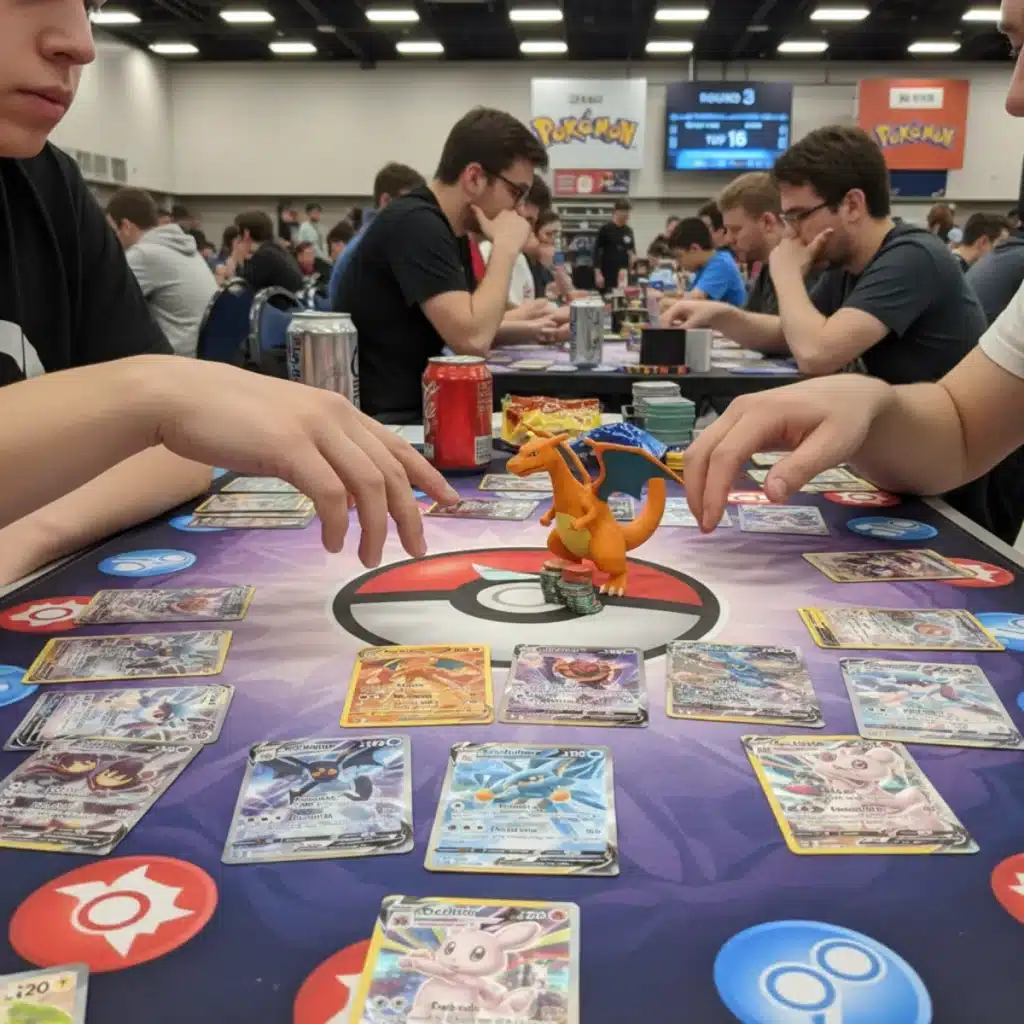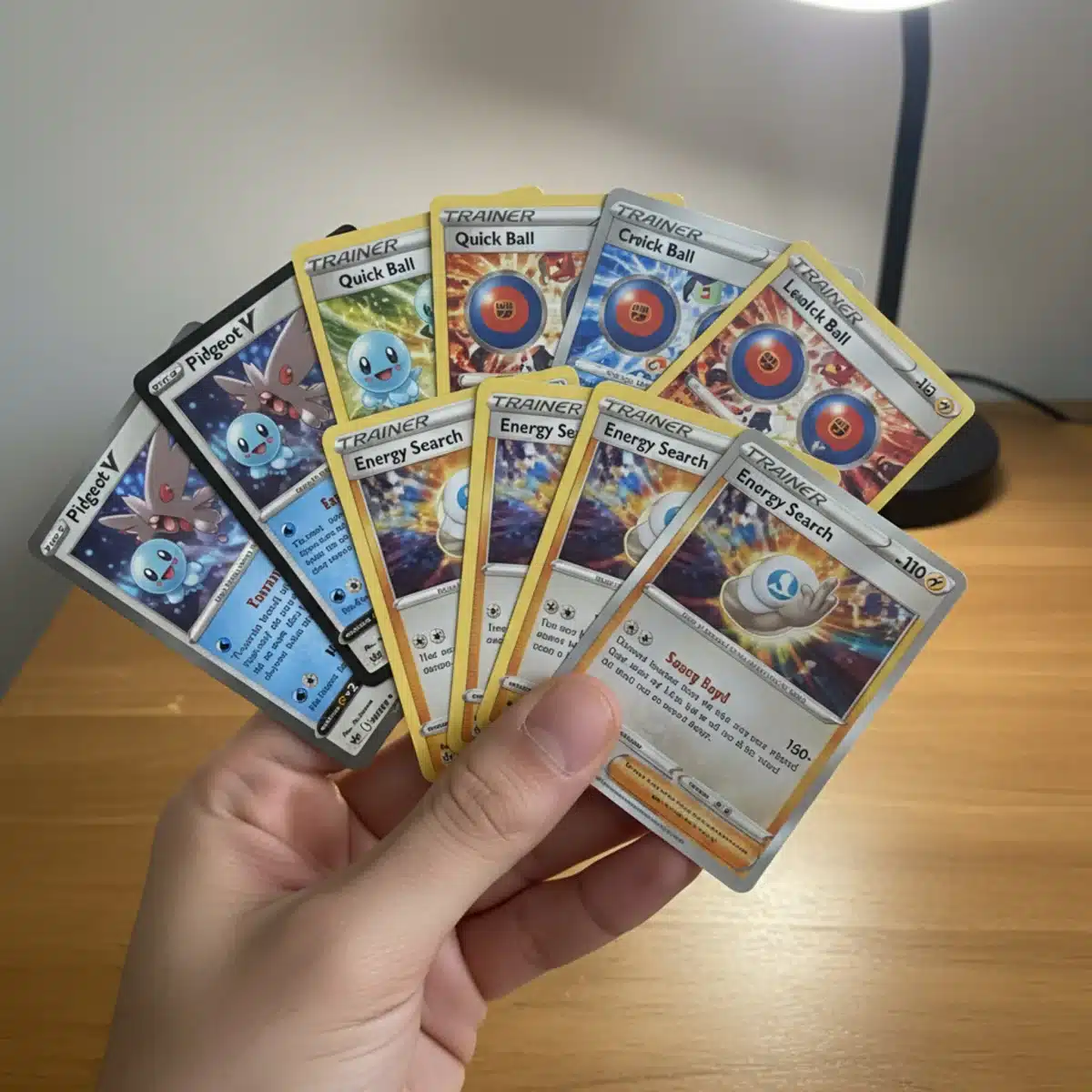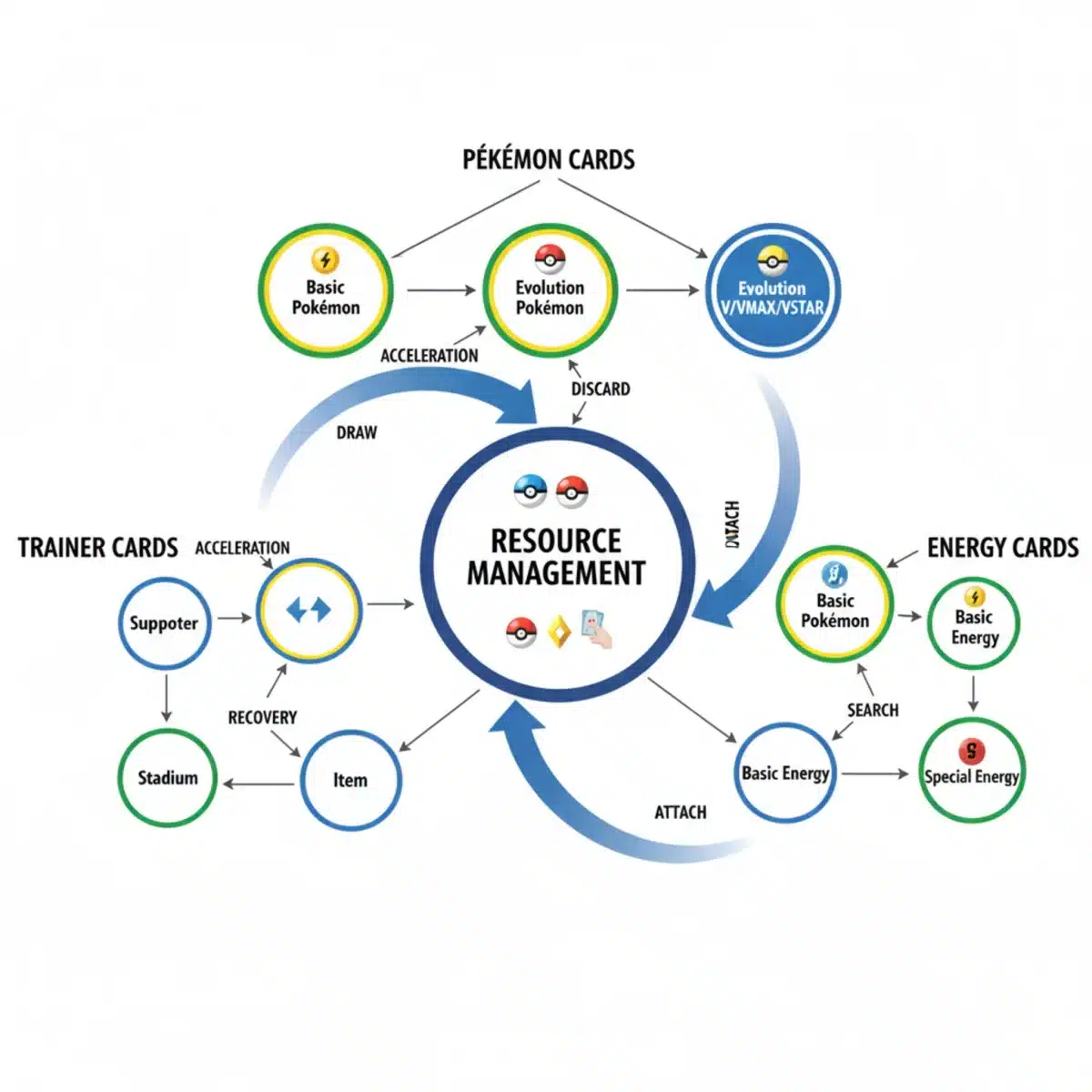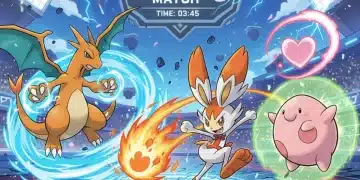Pokémon TCG: Budget Deck Wins Tournaments Under $50

Advertisements
Building a competitive Pokémon TCG deck for under $50 is entirely achievable by focusing on synergistic strategies, readily available cards, and mastering fundamental gameplay mechanics to secure tournament victories.
Are you ready to dive into the exciting world of Pokémon TCG tournaments but worried about the cost? Many players believe that winning requires an expensive collection, but that’s not always true. This guide will show you how to build a Pokémon TCG: Build a Budget-Friendly Deck That Can Win Tournaments for Under $50, proving that strategic thinking and smart card choices can lead to victory without breaking the bank. Let’s explore how to become a champion on a budget!
Anúncios
Understanding the Core of a Winning Budget Deck
Building a strong deck, especially on a budget, starts with understanding the fundamental principles of the Pokémon Trading Card Game. It’s not just about having powerful rare cards; it’s about how all your cards work together. A winning deck needs consistency, a clear strategy, and the ability to adapt to different opponents.
Anúncios
When you’re aiming for a budget-friendly approach, you’ll often find that common and uncommon cards can be just as effective, if not more so, than expensive rares when used correctly. The key is to identify cards that provide excellent utility, draw power, or strong attacks for their cost in energy and setup time.
Defining Your Deck Archetype
Before you even start looking at individual cards, you need a general idea of what your deck wants to accomplish. This is called your deck’s archetype. Common archetypes include:
- Aggro: Focuses on dealing quick, high damage to knock out opponent’s Pokémon rapidly.
- Control: Aims to disrupt the opponent’s strategy, limit their resources, and eventually win by locking them out of the game.
- Midrange: Balances early-game setup with strong mid-to-late game attackers.
- Setup/Combo: Relies on assembling specific cards to unleash a powerful, often game-ending, combination.
For a budget deck, aggro or simple midrange strategies are often the most accessible. They rely less on complex card interactions and more on straightforward damage output or efficient trades.
The Importance of Consistency
A consistent deck is one that can reliably execute its strategy game after game. This means including cards that help you draw more cards, search for specific Pokémon, or recover essential resources. Without consistency, even the most powerful cards won’t help if you can’t get them into play when you need them.
For example, cards like Professor’s Research or Supporters that allow you to draw a new hand are crucial. Similarly, search cards like Quick Ball (or its budget alternatives, depending on the format) ensure you can find your key Pokémon.
In conclusion, a solid foundation for any budget-friendly, tournament-winning deck involves choosing a clear archetype and prioritizing consistency in your card choices. These principles will guide you to make smart decisions within your $50 limit.
Strategic Card Selection: Pokémon, Trainers, and Energy
Once you have a general strategy in mind, it’s time to pick the actual cards. This is where the budget aspect truly comes into play. You’ll need to be selective, prioritizing cards that offer high value for their low cost. Remember, not every powerful effect comes with a high price tag.
The balance between your Pokémon, Trainer cards, and Energy cards is critical. A general rule of thumb is roughly 10-12 Basic Pokémon, 10-15 Evolution Pokémon (if applicable), 25-30 Trainer cards, and 10-15 Energy cards for a 60-card deck. However, this can vary significantly based on your chosen archetype.
Choosing Your Core Pokémon Lineup
Your main attackers should be efficient. Look for Pokémon with attacks that deal good damage for their energy cost, or have useful abilities that support your strategy. Stage 1 or Stage 2 Pokémon often offer better stats and attacks than Basic Pokémon, but they require more setup.
Budget-Friendly Attackers
- Vulpix (Silver Tempest): Its “Snowy Ascent” ability can search for any two Basic Pokémon, setting up your board quickly.
- Kirlia (Silver Tempest): Its “Refinement” ability lets you discard a card to draw two, providing crucial draw power.
- Bibarel (Brilliant Stars): With its “Industrious Incisors” ability, you can draw cards until you have 5 in hand, a staple for many budget decks.
These Pokémon might not be the flashiest, but their utility and consistent performance make them excellent budget choices. They enable your deck to function smoothly, allowing you to find the cards you need.
Essential Trainer Cards on a Budget
Trainer cards are the backbone of any competitive Pokémon TCG deck. They provide draw power, search capabilities, disruption, and healing. For a budget deck, focus on widely available and effective Trainer cards that don’t cost much.
Key Budget Trainer Cards
- Professor’s Research: Discard your hand and draw 7 new cards. Essential for refreshing your hand.
- Marnie/Iono: Disrupts your opponent’s hand while giving you a fresh hand. Great for controlling the game state.
- Ultra Ball/Nest Ball/Level Ball: These are crucial for searching out specific Pokémon from your deck. Prioritize those that fit your Pokémon’s HP and evolution stages.
- Energy Search: A simple card that allows you to find a basic Energy card from your deck.
These Trainer cards ensure your deck runs smoothly and consistently, allowing you to execute your strategy without relying on lucky draws. They are often common or uncommon cards, keeping costs down.

Energy Lineup Considerations
Energy cards power your Pokémon’s attacks. The number and type of energy you include depend entirely on your Pokémon. Most budget decks benefit from focusing on one or two energy types to maintain consistency. Avoid decks that require many different types of energy, as this can make setup challenging.
Special Energy cards can be powerful but are often more expensive. Stick to basic Energy cards to keep your costs low. A good starting point is 10-12 basic Energy cards, adjusted based on your Pokémon’s energy requirements.
In summary, strategic card selection for a budget deck involves choosing efficient Pokémon, prioritizing essential Trainer cards for consistency and disruption, and streamlining your Energy lineup. This careful balance ensures you get the most out of every dollar spent.
Building a Sample Budget Deck: The “Snowy Kirlia” Strategy
Let’s put theory into practice and look at a sample budget-friendly deck that incorporates the principles we’ve discussed. This deck focuses on the synergy between Vulpix, Kirlia, and a strong, efficient attacker, all while maintaining a low price point. This archetype emphasizes consistency and steady damage output, perfect for tournament play under a budget.
The core idea is to quickly set up your board using Vulpix to find your Basic Pokémon, then use Kirlia to cycle through your deck to find your attackers and essential Trainer cards. The main attacker will be a common yet powerful Pokémon that can trade favorably with many popular threats.
Core Pokémon Lineup Breakdown
For our “Snowy Kirlia” deck, we’ll focus on a few key Pokémon lines:
- 4-4 Vulpix/Ninetales (Silver Tempest): Vulpix’s “Snowy Ascent” ability is a fantastic setup tool. Ninetales can be a decent attacker or a secondary utility if needed, though Vulpix is the star here.
- 4-4 Ralts/Kirlia (Silver Tempest): Kirlia’s “Refinement” ability is our primary draw engine, ensuring we keep seeing new cards. We don’t necessarily need Gardevoir in a budget build, as Kirlia provides enough utility.
- 2-2 Bidoof/Bibarel (Brilliant Stars): Another strong draw engine with “Industrious Incisors,” giving us more hand replenishment options.
- 2-2 Hawlucha (Scarlet & Violet): Its “Flying Entry” allows it to be put directly into play when you play it from your hand, and its “Jet Punch” attack deals 30 damage to two of your opponent’s Benched Pokémon, perfect for chipping away at their setup.
- 2-2 Donphan (Paldea Evolved): “Rolling Tackle” for 100 damage and 20 self-damage, or “Spinning Attack” for 130 damage for three fighting energy. A sturdy, straightforward attacker.
This Pokémon lineup provides both setup and consistent damage. Vulpix and Kirlia ensure you find your pieces, while Hawlucha and Donphan provide reliable damage output. The blend of abilities and attacks makes this a versatile and resilient deck.
Essential Trainer Cards for Consistency and Control
To support our Pokémon, we need a robust Trainer lineup. These cards will help us find our Pokémon, draw new cards, and disrupt our opponent’s plans.
Key Trainer Cards for the “Snowy Kirlia” Deck
- 4 Professor’s Research: Max hand refresh.
- 2 Iono: Hand disruption and refresh.
- 2 Boss’s Orders: Pulls an opponent’s Benched Pokémon into the Active spot, allowing you to target specific threats.
- 4 Nest Ball: Search for any Basic Pokémon.
- 3 Ultra Ball: Discard 2 cards to search for any Pokémon. Essential for finding evolutions.
- 2 Energy Search: Finds a basic Energy card.
- 2 Switch: Swaps your Active Pokémon with one of your Benched Pokémon. Crucial for managing retreat costs.
- 2 Pal Pad: Puts 2 Supporter cards from your discard pile back into your deck. Recycles key Supporters.
- 2 Super Rod: Shuffles 3 in any combination of Pokémon and basic Energy cards from your discard pile into your deck. Recovers resources.
This Trainer suite is designed for maximum consistency. Professor’s Research and Iono keep your hand full, while Nest Ball and Ultra Ball ensure you can set up your board quickly. Boss’s Orders allows for strategic knockouts, and Switch helps manage your Active Pokémon.
Energy Allocation
Given Donphan as a primary attacker, our energy will primarily be Fighting type.
- 10 Fighting Energy: Sufficient to power up Donphan and other potential fighting-type attackers.
The simplicity of a single energy type keeps the deck consistent and easy to manage, which is vital for a budget build. By carefully selecting these readily available cards, you create a cohesive and powerful strategy without exceeding your $50 limit.
Playing Your Budget Deck: Strategies and Tactics
Having a well-built deck is only half the battle; knowing how to play it effectively is just as important. With a budget deck, maximizing every card’s potential and understanding your win condition is crucial. This means focusing on efficient resource management, knowing when to attack, and when to prioritize setting up your board.
Your goal with the “Snowy Kirlia” deck is to establish your draw engines (Kirlia, Bibarel) early, use Vulpix to populate your bench, and then consistently attack with Donphan while using Hawlucha to spread damage. Don’t underestimate the power of chipping away at your opponent’s benched Pokémon.
Early Game Setup
The first few turns are critical. Your priority should be to get your Basic Pokémon into play and evolve them into Kirlia and Bibarel as quickly as possible. Use Professor’s Research or Iono to draw into your essential setup cards.
If Vulpix is in your opening hand, use its “Snowy Ascent” ability to search for Ralts and Bidoof. This accelerates your board development significantly. Always aim to have at least two Basic Pokémon on your bench by the end of your first turn, if not more, to protect against early knockouts.
Mid-Game Aggression and Resource Management
Once your draw engines are online, you should be able to consistently find Energy and your main attacker, Donphan. Start attaching Energy to Donphan and getting it ready to attack. Use Kirlia’s “Refinement” and Bibarel’s “Industrious Incisors” every turn to keep your hand full and search for key cards.
Consider when to use Hawlucha’s “Jet Punch.” Spreading 30 damage to two benched Pokémon can set up future knockouts or soften up threats for Donphan. Keep track of your discard pile, especially your Supporters and key Pokémon. Use Pal Pad and Super Rod to recycle them when necessary.

Late Game Closers and Adapting to Opponents
In the late game, your focus shifts to taking your remaining Prize cards. This often involves using Boss’s Orders to target damaged Pokémon on your opponent’s bench or their weaker support Pokémon. Donphan’s consistent damage should be enough to finish the game.
Always be aware of your opponent’s deck. Are they setting up a big attacker? Are they disrupting your hand? Adapt your strategy accordingly. If they have a strong active Pokémon, consider using Switch to pivot or try to disrupt their energy attachments with Iono. The ability to adapt is a hallmark of a skilled player, regardless of deck cost.
Playing a budget deck effectively means being disciplined with your resources, understanding your deck’s strengths, and constantly looking for ways to maximize your card advantage. Practice will make perfect, and you’ll soon find yourself making winning plays.
Budget-Friendly Card Acquisition and Trading Tips
One of the biggest hurdles when building a budget deck is actually acquiring the cards without exceeding your $50 limit. Fortunately, there are several strategies you can employ to get the cards you need at a low cost. This involves smart shopping, effective trading, and knowing where to look for deals.
Remember, your goal is to get the most value for your money. This often means avoiding single cards that are currently hyped or highly sought after, and instead focusing on reliable, underappreciated options.
Online Retailers and Card Marketplaces
Websites like TCGplayer, Card Kingdom, or local game store online shops are excellent places to buy single cards. Always compare prices across different sellers to find the best deals. Look for cards listed as “Near Mint” or “Lightly Played” to ensure good condition without paying a premium for “Mint” condition.
Tips for Online Shopping
- Buy from a single seller: Consolidating your purchases with one seller often saves on shipping costs.
- Check seller ratings: Ensure the seller has a good reputation for accurate descriptions and timely shipping.
- Utilize filters: Filter by rarity (common, uncommon) to quickly find budget-friendly options.
Online marketplaces are transparent and allow you to quickly see the market price for cards, helping you stay within your budget.
Local Game Stores and Trading
Your local game store (LGS) can be a treasure trove for budget cards. Many LGSs have a common/uncommon bin where you can find cards for pennies. Building relationships with other players at your LGS can also open up trading opportunities.
Effective Trading Strategies
- Know your card values: Use online resources to understand the market value of cards you want to trade for and those you own.
- Trade up, not down: Try to trade multiple low-value cards for one slightly higher-value card you need, or trade cards you don’t use for ones you do.
- Be fair and respectful: A good trading relationship is built on mutual respect and fair deals.
Trading is a fantastic way to acquire cards without spending money, but it requires patience and a good understanding of card values. Always double-check conditions and make sure both parties are happy with the trade.
By combining smart online shopping with local store exploration and strategic trading, you can efficiently acquire all the cards needed for your budget-friendly, tournament-winning deck without exceeding your $50 limit.
Practicing and Refining Your Deck for Tournaments
Once your budget-friendly deck is assembled, the journey isn’t over. The next crucial step is to practice extensively and refine your deck. Even the most powerful and expensive decks won’t win without a skilled pilot. For a budget deck, understanding every single card’s role and mastering your strategy is even more vital.
Practice helps you identify weaknesses in your deck, understand different matchups, and improve your decision-making under pressure. Don’t expect to win every game immediately; learning from losses is a key part of becoming a better player.
Testing Against Different Matchups
Playtest your deck against a variety of other popular decks. If you don’t have friends with diverse collections, online simulators like Pokémon TCG Live are excellent resources for testing your deck against the current meta. This will help you understand how your budget deck performs against different strategies.
Key aspects to observe during testing:
- Consistency: Are you consistently getting your draw engines and attackers set up?
- Win condition: Are you able to execute your main strategy and take all six Prize cards?
- Weaknesses: What are your deck’s biggest vulnerabilities? What kinds of cards or strategies give you trouble?
- Optimal plays: Are there better sequences of plays you could have made?
By rigorously testing, you’ll gain confidence in your deck’s abilities and identify areas for improvement.
Making Adjustments and Tech Choices
Based on your playtesting, you might find that certain cards aren’t performing as well as expected, or that you need specific “tech cards” to counter common threats. Tech cards are usually one-of or two-of inclusions designed to address a particular problem in the meta.
For a budget deck, tech choices need to be carefully considered. Look for common or uncommon cards that can provide unexpected utility. For example, a Pokémon with a specific type resistance or an ability that disrupts a popular strategy can be invaluable. Always evaluate if a tech card still fits within your budget and overall strategy.
Refining your deck is an ongoing process. The meta constantly shifts, and new cards are released. Stay informed about the competitive landscape and be willing to make small adjustments to keep your budget deck competitive. This continuous cycle of practice, evaluation, and refinement will transform your affordable deck into a tournament contender.
The Mindset of a Budget Tournament Champion
Beyond the cards and strategies, a crucial element for success in Pokémon TCG tournaments, especially with a budget deck, is having the right mindset. Confidence, focus, and a positive attitude can significantly impact your performance. Remember, you’re competing against players who might have spent hundreds or thousands on their decks, but skill and strategy can often overcome raw power.
Embrace the challenge of proving that a budget deck can win. This underdog mentality can fuel your determination and focus, leading to surprising victories. Your goal isn’t just to play, but to learn, adapt, and enjoy the game, regardless of the outcome.
Confidence in Your Deck
Believe in your deck’s ability to win. You’ve carefully selected each card, practiced your strategy, and refined your plays. Approach each game with the conviction that your deck can compete with the best. This confidence will help you make clearer decisions and perform better under pressure.
Don’t be intimidated by expensive cards or popular archetypes your opponents might be playing. Focus on your own game plan and how to execute it most effectively against their setup. Your budget deck has a strong core; trust in it.
Focus and Adaptability During Games
Stay focused throughout each match. Pay close attention to your opponent’s board, their discard pile, and the cards they play. Try to anticipate their next moves and plan your turns accordingly. This awareness allows you to adapt your strategy on the fly, which is crucial when piloting a budget deck that might have fewer “out of nowhere” plays.
If a game isn’t going your way, don’t give up. Look for alternative win conditions or ways to disrupt your opponent’s momentum. Sometimes, a single well-timed Boss’s Orders or Iono can turn the tide of a game. Your budget deck might not have every answer, but it has enough tools to compete.
Learning from Every Match
Whether you win or lose, every game is an opportunity to learn. After each match, take a moment to reflect. What went well? What could you have done differently? Did you miss any optimal plays? Understanding your mistakes is the fastest way to improve.
Engage with your opponents respectfully. Ask them about their deck or specific plays. You might gain valuable insights into different strategies or how your deck performs against theirs. This continuous learning process, combined with a strong, budget-friendly deck, will set you on the path to becoming a true tournament champion.
Cultivating a champion’s mindset means having confidence in your preparation, maintaining focus during play, and continuously learning. This mental fortitude, alongside a well-constructed budget deck, positions you for success in any Pokémon TCG tournament.
| Key Strategy | Brief Description |
|---|---|
| Consistency Focus | Prioritize cards that offer reliable draw power and search capabilities to ensure smooth deck operation. |
| Efficient Attackers | Select Pokémon with strong damage output relative to their energy cost, often found in common/uncommon rarities. |
| Smart Resource Management | Carefully manage your hand, energy, and discard pile, using Trainer cards to recycle and optimize plays. |
| Extensive Playtesting | Practice frequently against diverse opponents to refine strategies and identify deck weaknesses. |
Frequently Asked Questions About Budget Pokémon TCG Decks
Absolutely! Many budget decks focus on strong, consistent strategies using readily available cards. Success often comes down to player skill, understanding game mechanics, and making optimal plays rather than just card rarity or price. With practice and smart deck building, a budget deck can definitely win tournaments.
For a budget deck, focus on consistency cards like draw Supporters (Professor’s Research, Iono), Pokémon search cards (Nest Ball, Ultra Ball), and efficient attackers. These cards help you set up your board quickly and execute your strategy reliably, which is paramount when working with a limited card pool.
Online retailers like TCGplayer or Card Kingdom are great for buying singles. Also, check your local game store’s common/uncommon bins, as they often contain valuable cards for very low prices. Trading with other players at your local events can also be an excellent way to acquire cards without spending money.
Look for Pokémon that have attacks with good damage output for their energy cost. They should be relatively easy to set up and evolve. Often, Stage 1 or even some powerful Basic Pokémon from recent sets can be very effective without being expensive, providing a strong core for your offense.
Extensive playtesting is key. Play against friends, use online simulators like Pokémon TCG Live, and participate in local casual events. Pay attention to how your deck performs against different archetypes, identify weaknesses, and don’t be afraid to make small adjustments to optimize your card choices.
Conclusion
Building a competitive Pokémon TCG deck for under $50 is not just a pipe dream; it’s an achievable goal for any dedicated player. By understanding the core principles of deck building, making strategic card choices, and rigorously practicing, you can create a powerful deck capable of holding its own in tournaments. Remember that skill, consistency, and a positive mindset are often more impactful than the monetary value of your cards. Embrace the challenge, refine your strategy, and prove that a budget-friendly deck can indeed be a champion’s deck. The world of Pokémon TCG is open to everyone, regardless of their budget, and with the right approach, you can find success and enjoyment while showcasing your strategic prowess.





